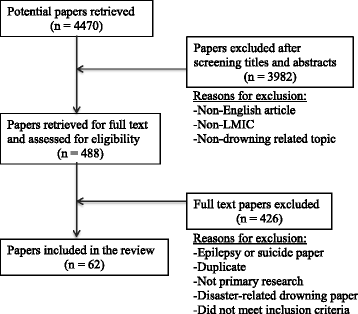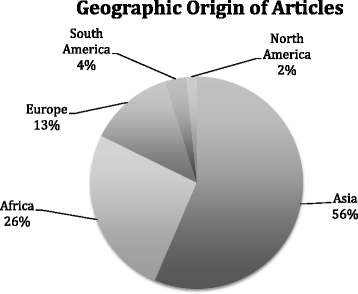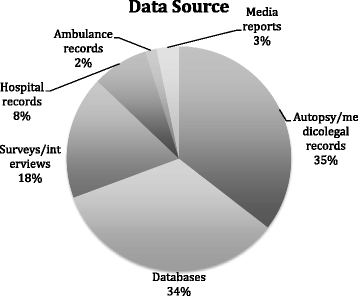The epidemiology of drowning in low- and middle-income countries: a systematic review
- PMID: 28482868
- PMCID: PMC5423024
- DOI: 10.1186/s12889-017-4239-2
The epidemiology of drowning in low- and middle-income countries: a systematic review
Abstract
Background: According to the World Health Organization, drowning is the 3rd leading cause of unintentional injury-related deaths worldwide, accounting for 370,000 annual deaths and 7% of all injury-related deaths. Low- and middle-income countries are the most affected, accounting for 91% of unintentional drowning deaths.
Methods: The authors performed a systematic review of literature indexed in EMBASE, PubMed, Web of Science, Cochrane Library, and Traumatology journals formerly indexed in PubMed in January 2014 and again in September 2016. Abstracts were limited to human studies in English, conducted in low- and middle-income countries, and containing quantitative data on drowning epidemiology.
Results: A total of 62 articles met inclusion criteria. The majority of articles originate from Asia (56%) and Africa (26%). Risk factors for drowning included young age (<17-20 years old), male gender (75% vs. 25% female), rural environment (84% vs. 16% urban), occurring in the daytime (95% vs. 5% night time), lack of adult supervision (76% vs. 18% supervised), and limited swimming ability (86% vs. 10% with swimming ability). There was almost equal risk of drowning in a small body of water versus a large body of water (42% ponds, ditches, streams, wells; 46% lakes, rivers, sea, ocean).
Conclusion: Drowning is a significant cause of injury-related deaths, especially in LMICs. Young males who are unsupervised in rural areas and have limited formal swimming instruction are at greatest risk of drowning in small bodies of water around their homes. Preventative strategies include covering wells and cisterns, fencing off ditches and small ponds, establishing community daycares, providing formal swimming lessons, and increasing awareness of the risks of drowning.
Keywords: Drowning; Drowning prevention; Epidemiology; Injury; Low and middle-income countries; Public health; Systematic review.
Figures
References
-
- World Health Organization. Global report on drowning: preventing a leading killer. World Health Organization; 2014.
-
- UNICEF. Convention on the rights of the child. 1989; http://www.unicef-irc.org/portfolios/crc.html. Accessed October 24, 2016.
-
- World Health Organization. World report on child injury prevention. World Health Organization; 2008. - PubMed
-
- Linnan M, Anh LV, Cuong PV. Special series on child injury: child mortality and injury in Asia: survey results and evidence. UNICEF Innocenti Research Center: Florence, Italy; 2007.
Publication types
MeSH terms
LinkOut - more resources
Full Text Sources
Other Literature Sources
Medical
Miscellaneous




